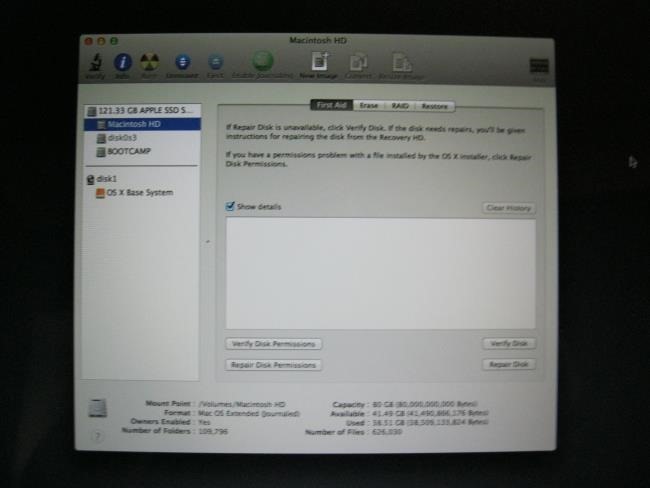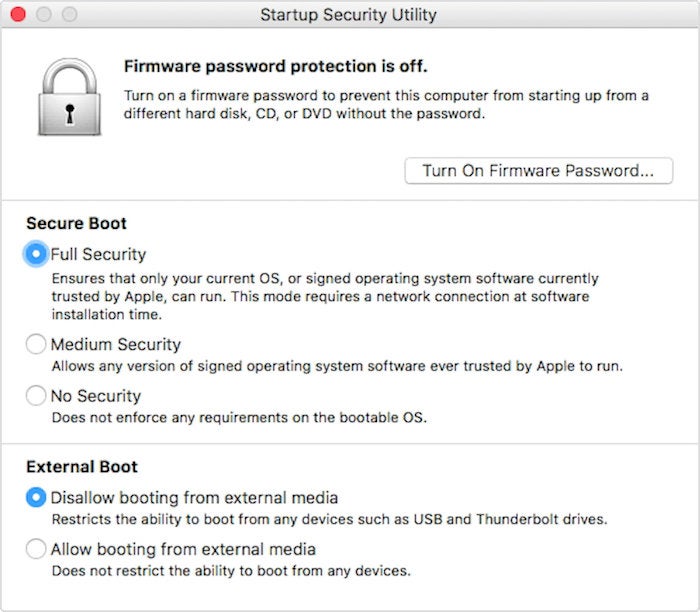
- #Mac secure boot how to#
- #Mac secure boot update#
- #Mac secure boot upgrade#
- #Mac secure boot windows 10#
- #Mac secure boot software#
It might contribute to reducing the boot time on your Mac as well. Just reset your Mac’s PRAM/NVRAM to improve the booting speed:Īlso, try reindexing Spotlight. Such memory is used to store all kinds of settings (e.g., designated startup disk).

Macs possess a special type of memory known as PRAM/NVRAM. By clearing the startup settings, you eliminate the wrong settings that prevent the boot process from being fast. The next good idea is to reset PRAM/NVRAM.

#Mac secure boot how to#
So, how to prevent these things from launching? What do login items include? Those are helper daemons, menu bar items, and full-blown applications. What about the startup applications and login items? If you prevent the apps from automatically launching at boot, they will stop increasing the boot time. If Disk Utility detects a problem, choose Repair Disk. Then, select Verify Disk to scan for mistakes. In case of the reported problem, pick Repair Disk Permissions.

Launch Disk Utility (your Spotlight or Finder will help to find it).It helps to check and fix hard drive problems that could lead to the slowdown in the booting process.Īs far as it is considered the easiest trick, you should try this one first. The first way to speed up your Mac boot time is to verify the hard drive and permissions. How to Speed up Your Mac Boot Time with Onboard Tools Although the methods listed below are time-proven and usually do not cause the data loss, it’s always better to be safe than sorry. I will give you the idea how to do that.īefore we get to the matter of the article, please, make sure to backup all your data to prevent losing any important file(s). After all, most of us want to save money instead of wasting them every time our devices stop working the way they should. However, not every user is ready to shell out couple hundred dollars for the 256GB or even 128GB disk in addition to not-so-cheap Mac. The best way to stop your suffering is to purchase a solid state drive (SSD) and set up macOS on it. Launching the resource-hungry processes.In most cases, the boot time extends due to the: It may spoil the overall positive impression of using Apple products. It seems that your machine takes forever to reboot.
#Mac secure boot windows 10#
While the requirement to upgrade a Windows 10 device to Windows 11 is only that the PC be Secure Boot capable by having UEFI/BIOS enabled, you may also consider enabling or turning Secure Boot on for better security.I guess every Mac user has faced the problem of the increased boot time. Here are a few links to information from some PC manufacturers to help get you started: If you are unsure how to make any necessary changes to enable the UEFI/BIOS, we recommend that you check your PC manufacturer’s support information on their website. If so, you will need to choose for UEFI to be the first or only option.

In some cases, there are options to enable both UEFI and Legacy/CSM. To change these settings, you will need to switch the PC boot mode from one enabled as “Legacy” BIOS (also known as “CSM” Mode) to UEFI/BIOS (Unified Extensible Firmware Interface).
#Mac secure boot update#
To access these settings, you can consult your PC manufacturer’s documentation or follow these instructions: Run Settings > Update & Security > Recovery and select Restart now under Advanced startup. From the next screen, select Troubleshoot > Advanced options > UEFI Firmware Settings > Restart to make changes. Firmware, often called BIOS (Basic Input/Output System), is the software that starts up before Windows when you first turn on your PC. Most modern PCs are capable of Secure Boot, but in some instances, there may be settings that cause the PC to appear to not be capable of Secure Boot. These settings can be changed in the PC firmware.
#Mac secure boot software#
Secure Boot is an important security feature designed to prevent malicious software from loading when your PC starts up (boots).
#Mac secure boot upgrade#
This article is intended for users who are not able to upgrade to Windows 11 because their PC is not currently Secure Boot capable. If you are unfamiliar with this level of technical detail, we recommend that you consult your PC manufacturer’s support information for more instructions specific to your device.


 0 kommentar(er)
0 kommentar(er)
